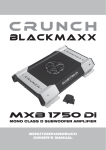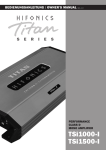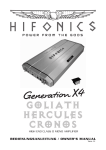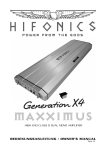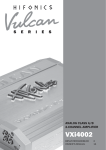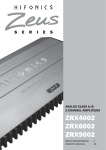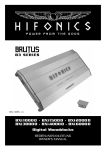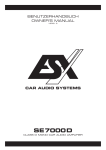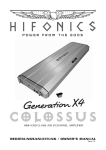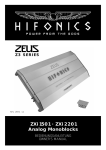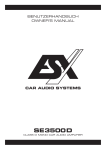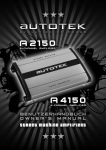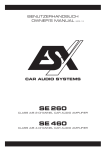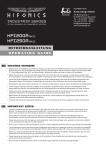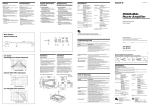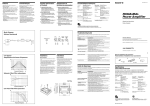Download BRX12000D
Transcript
VERS. 1.1 DIGITAL ULTRA CLASS D MONO AMPLIFIERS BRX12000D BENUTZERHANDBUCH OWNER‘S MANUAL 2 16 INHALTSVERZEICHNIS SICHERHEITSHINWEISE3 INSTALLATIONSHINWEISE4 Mechanische Installation....................................................................................................................4 Elektrische Anschlüsse.......................................................................................................................5 FUNKTIONSHINWEISE6 Funktionen und Bedienelemente........................................................................................................6 Anschlussbeispiele.............................................................................................................................8 • Normal-Modus: Subwoofer-Betrieb..................................................................................................8 • Master/Slave-Modus: Subwoofer-Betrieb mit zwei Verstärkern.......................................................9 Einstellbereiche der Filter................................................................................................................. 11 ALLGEMEINE HINWEISE 12 Technische Daten.............................................................................................................................12 Garantiehinweis................................................................................................................................12 FEHLERBEHEBUNG13 OPTIONALES ZUBEHÖR HINWEIS 15 Dieses Symbol weist Sie auf wichtige Hinweise auf den folgenden Seiten hin. Bei Nichtbeachtung besteht die Gefahr das zu installierende Gerät oder Teile des Fahrzeugs zu beschädigen. Zudem könnten schwere lebensgefährliche Verletzungen bei Nichtbeachtung hervorgerufen werden. BITTE BEWAHREN SIE DIE BEDIENUNGSANLEITUNG FÜR SPÄTERE ZWECKE AUF! 2 SICHERHEITSHINWEISE BITTE BEACHTEN SIE DIE FOLGENDEN HINWEISE VOR INBETRIEBNAHME! DAS VON IHNEN ERWORBENE GERÄT IST NUR FÜR DEN BETRIEB AN EINEM 12-V-BORDNETZ EINES FAHRZEUGS AUSGELEGT. Andernfalls besteht Feuergefahr, die Gefahr eines elektrischen Schlages oder anderer Verletzungen. BITTE KEINE BEDIENUNG DES SOUNDSYSTEMS AUSFÜHREN, WELCHE VOM SICHEREN LENKEN DES FAHRZEUGS ABLENKEN KÖNNTE. Führen Sie keine Bedienungen aus, die Ihre Aufmerksamkeit längere Zeit in Anspruch nehmen. Stoppen Sie besser das Fahrzeug an einer sicheren Stelle am Straßenrand, bevor Sie solche Bedienungen ausführen. Andernfalls besteht Unfallgefahr. DIE LAUTSTÄRKE NUR SO HOCH EINSTELLEN, DASS SIE WÄHREND DER FAHRT NOCH AUSSENGERÄUSCHE WAHRNEHMEN KÖNNEN. Hochleistungsaudiosysteme in Fahrzeugen, können den Schallpegel eines “Live-Konzertes” erzeugen. Dauerhaft extrem lauter Musik ausgesetzt zu sein kann den Verlust des Hörvermögens oder Hörschäden zur Folge haben. Das Hören von lauter Musik beim Autofahren kann Ihre Wahrnehmung (Warnsignale) beeinträchtigen. Im Interesse der allgemeinen Sicherheit empfehlen wir das Musikhören beim Autofahren mit geringer Lautstärke. Andernfalls besteht Unfallgefahr. LÜFTUNGSÖFFNUNGEN UND KÜHLKÖRPER NICHT ABDECKEN. Andernfalls kann es zu einem Wärmestau im Gerät kommen und es besteht Feuergefahr. DAS GERÄT AUF KEINEN FALL ÖFFNEN. Andernfalls besteht Unfallgefahr, Feuergefahr oder die Gefahr eines elektrischen Schlages. Das Öffnen des Gerätes hat auch einen Garantieverlust zur Folge. SICHERUNGEN IMMER DURCH SOLCHE MIT DER RICHTIGEN AMPEREZAHL ERSETZEN. Andernfalls besteht Feuergefahr oder die Gefahr eines elektrischen Schlages. DAS GERÄT NICHT WEITERBENUTZEN, WENN EINE FEHLFUNKTION AUFTRITT, DIE NICHT VON IHNEN BEHOBEN WERDEN KANN. Beachten Sie dazu den Abschnitt FEHLERBEHEBUNG. Andernfalls kann es zu Verletzungen oder Schäden am Gerät kommen. Geben Sie das Gerät zu Reparaturzwecken an einen autorisierten Händler oder den nächsten Kundendienst. DIE INSTALLATION EINES PUFFERKONDENSATORS MIT AUSREICHENDER KAPAZIÄT WIRD EMPFOHLEN. Hochleistungsverstärker verursachen sehr hohe Spannungsabfälle und benötigen eine sehr hohe Stromstärke bei hoher Leistung. Um das Bordnetz des Fahrzeuges nicht übermäßig zu belasten, wird die Installation eines Pufferkondensators (auch Pufferelko, Powercap oder Power Capacitor genannt) empfohlen, der parallel zum Verstärker und zur Stromquelle als Puffer fungiert. Lassen Sie sich am besten im Car Audio Fachhandel beraten. VERKABELUNG UND EINBAU VON FACHPERSONAL AUSFÜHREN LASSEN. Die Verkabelung und der Einbau dieses Gerätes erfordern technisches Geschick und Erfahrung. Zu Ihrer eigenen Sicherheit sollten Sie Verkabelung und Einbau dem Händler überlassen, bei dem Sie das Gerät erworben haben. DAS GERÄT NICHT AN STELLEN EINBAUEN, AN DENEN ES HOHER FEUCHTIGKEIT ODER STAUB AUSGESETZT IST. Bauen Sie das Gerät so ein, dass es vor hoher Feuchtigkeit und Staub geschützt ist. Wenn Feuchtigkeit oder Staub in das Gerät gelangen, kann es zu Betriebsstörungen kommen. Schäden am Gerät, welche durch Feuchtigkeit hervorgerufen wurden, unter- liegen nicht der Garantie. DAS GERÄT SOWIE ANDERE KOMPONENTEN DES SOUNDSYSTEMS AUSREICHEND BEFESTIGEN. Andernfalls könnten sich die Geräte und Komponenten während der Fahrt lösen und als gefährliche Geschosse im Fahrgastraum Beschädigungen und Verletzungen hervorrufen. BEIM BOHREN VON LÖCHERN, BESTEHENDE KOMPONENTEN, LEITUNGEN UND KABEL DES FAHRZEUGS NICHT BESCHÄDIGEN. Wenn Sie bei der Installation Löcher in das Fahrzeugchassis bohren, achten Sie unbedingt darauf die Kraftstoffleitungen, den Benzintank, elektrische Kabel und andere Leitungen nicht zu beschädigen, zu berühren oder zu blockieren. AUF KORREKTE ANSCHLÜSSE ACHTEN. Bei fehlerhaften Anschlüssen besteht Feuergefahr, Kurzschlussgefahr und es kann zu Schäden am Gerät kommen. AUDIOKABEL UND STROMKABEL SOLLTEN NICHT ZUSAMMEN VERLEGT WERDEN. Bei der Installation des Audiokabels zwischen dem Cinch-Ausgang des Autoradios und dem Cinch-Eingang des Verstärkers im Fahrzeug ist darauf zu achten, dass das Audio- und das Stromversorgungskabel möglichst nicht auf der selben Seite des Fahrzeugs verlegt werden. Besser ist eine räumlich getrennte Installation, im rechten und linken Kabelschacht des Fahrzeugs. Damit wird das Überlagern von Störungen auf das Audio-Signal verringert. Dieses gilt ebenfalls für das Verbindungskabel der beiliegenden Kabel-Fernbedienung. Das Kabel sollte nicht auf der Seite der Stromversorgungsleitung verlegt werden, sondern zusammen mit den Audiokabeln. SORGEN SIE DAFÜR, DASS SICH DIE KABEL NICHT IN GEGENSTÄNDEN IN DER NÄHE VERFANGEN. Verlegen Sie die Kabel wie auf den folgenden Seiten beschrieben, damit diese beim Fahren nicht hinderlich sind. Kabel die sich im Bereich des Lenkrads, des Schalthebels oder im Bremspedal usw. verfangen können, führen zu äußerst gefährlichen Situationen. ELEKTRISCHE KABEL NICHT SPLEISSEN. Kabel dürfen nicht abisoliert werden, um andere Geräte mit Strom zu versorgen. Andernfalls wird die Strombelastbarkeit des Kabels überschritten, und es besteht Feuergefahr oder die Gefahr eines elektrischen Schlages. Verwenden Sie hierfür am besten geeignete Verteilerblöcke. BOLZEN UND MUTTERN DER BREMSANLAGE NICHT ALS MASSEPUNKT VERWENDEN. Verwenden Sie für den Einbau oder Masseanschluss keine Bolzen oder Muttern der Brems- bzw. Lenkanlage oder eines anderen sicherheitsrelevanten Systems. Andernfalls besteht Feuergefahr oder die Fahrsicherheit ist beeinträchtigt. VOR DER INSTALLATION DAS KABEL VOM MASSEPOL DER BATTERIE ABKLEMMEN. Bevor Sie mit der Installation des Soundsystems beginnen, trennen Sie unbedingt den Massepol der Autobatterie ab, um Kurzschlüsse und Stromschläge zu vermeiden. DIE KABEL SO VERLEGEN, DASS SIE NICHT GEKNICKT ODER DURCH SCHARFE KANTEN GEQUETSCHT WERDEN. Verlegen Sie die Kabel so, dass sie sich nicht in beweglichen Teilen wie den Sitzschienen vefangen oder an scharfen Kanten oder spitzen Ecken beschädigt werden können. Wenn Sie ein Kabel durch eine Bohrung in einer Metallplatte führen, schützen Sie die Kabelisolierung mit einer Gummitülle vor Beschädigungen durch Metallkanten der Bohrung. WÄHLEN SIE EINEN GEEIGNETEN EINBAUORT. Suchen Sie einen geeigneten Einbauort für das Gerät, bei dem ausreichend Raum für eine kühlende Luftzirkulation vorherrscht. Am besten geeignet sind Reserveradmulden und offene Bereiche im Kofferraum. Weniger geeignet sind Stauräume hinter der Seitenverkleidung oder Bereiche unter den Fahrzeugsitzen. KLEINTEILE WIE SCHRAUBEN UND ANSCHLUSS-STECKER VON KINDERN FERNHALTEN. Werden solche Gegenstände verschluckt, besteht die Gefahr schwerwiegender Verletzungen. Suchen Sie unverzüglich einen Arzt auf, sollte ein Kind einen solchen Gegenstand verschluckt haben. 3 INSTALLATIONSHINWEISE HINWEIS Bevor Sie mit der Installation des Soundsystems beginnen, trennen Sie unbedingt den Massepol der Fahrzeugbatterie ab, um Kurzschlüsse und Stromschläge zu vermeiden. MECHANISCHE INSTALLATION Achten Sie bei der Installation darauf, dass keine serienmäßig im KFZ vorhandenen Teile wie z.B. Kabel, Bordcomputer, Sicherheitsgurte, Tank oder ähnliche Teile beschädigt bzw.entfernt werden. Vergewissern Sie sich, dass der Verstärker am Montageort genügend Kühlung erhält. Montieren Sie das Gerät nicht in zu kleine, abgeschlossene Gehäuse ohne Luftzirkulation, in die Nähe von wärmeabstrahlende Teilen oder elektronischen Steuerungen des Fahrzeuges. Montieren Sie den Verstärker auf keinen Fall auf ein Bassgehäuse oder andere vibrierende Teile, dadurch können sich die Bauteile im Verstärkerinneren losvibrieren und den Verstärker ernsthaft beschädigen. Die Kabel der Stromversorgung und die Audiosignalkabel sollten bei dem Einbau so kurz als möglich gehalten werden, um Verluste und Störungen zu vermeiden. 1 4x 2 4x Stift oder Körner Montageloch Belassen Sie dann den Verstärker an der gewünschten Einbaustelle im Fahrzeug. Markieren Sie die vier Bohrlöcher durch das jeweilige Montageloch an den Gussendteilen mit einem geeigneten Stift oder Körner. Suchen Sie zunächst einen geeigneten Einbauort für den Verstärker. Achten Sie darauf, dass ausreichend Platz für die Installation der Kabel vorhanden ist und diese nicht geknickt werden sowie eine ausreichende Zugentlastung gewährleistet ist. 3 4 4x Bohrer Markierung Legen Sie dann den Verstärker beiseite und bohren dann die Löcher für die Fixierschrauben an den zuvor markierten Punkten. Vergewissern Sie sich zuvor, dass keine Kabel, Leitungen und andere Komponenten des Fahrzeugs beim Bohren beschädigt werden. Alternativ können Sie auch (je nach Untergrund) selbstschneidende Gewindeschrauben verwenden. 4 4x FixierSchraube Montageloch Halten Sie dann den Verstärker wieder an die zuvor gewählte Position und verschrauben Sie den Verstärker mit geeigneten Schrauben an den zuvor gebohrten Bohrlöchern mit dem Fahrzeug. Achten Sie darauf, dass der verschraubte Verstärker fest sitzt und sich während der Fahrt nicht losvibriert. BALANCED INPUT L LEVEL PHASE FREQ. SUB RANGE Q-CONTROL BOOST SUB SONIC LP POWER L INSTALLATIONSHINWEISE MIN MAX 0° 180° 20Hz 80Hz WIDE NRW 0dB 18dB 15Hz 55Hz 35Hz 250Hz EXTENDED BASS CONTROL PROTECT BASS LEVEL CONTROLLER R R MASTER LINE IN BRX 12000 D SLAVE MODE SLAVE IN/OUT ELEKTRISCHE ANSCHLÜSSE GND +12V +12V GND LOGO BADGE SPEAKER OUTPUT BLUE WHITE POWER INPUT 1 2 BRX 12000 D 3 2 1 4 VOR DEM ANSCHLIESSEN Für den fachgerechten Anschluss des Soundsystems sind geeignete Kabelsets im Fachhandel erhältlich. Achten Sie beim Kauf auf einen ausreichenden Kabelquerschnitt (mind. 35 mm2), den passenden Sicherungswert sowie auf die Leitfähigkeit der Kabel. Säubern und entfernen Sie vorhandene Rost- und Oxidationsstellen an allen Kontaktpunkten der Batterie und an den Massepunkten. Ziehen Sie nach der Installation alle Schrauben fest an, denn ein lockerer Anschluss kann eine Fehlfunktion, unzureichende Stromversorgung oder Störgeräusche sowie Verzerrungen zur Folge haben. Der BRX12000D Verstärker besitzt jeweils zwei Masse- und zwei +12V Batterieanschlüsse, welche aufgrund der der hohen Ausgangsleistung alle angeschlossen werden müssen. 1 MASSEANSCHLÜSSE (GND) Verbinden Sie beide GND-Klemmen des Verstärkers mit einem geeigneten Massepunkt am Fahrzeugchassis. Die Massekabel sollten möglichst kurz sein und an einem blanken, metallischen Punkt des Fahrzeugchassis angebracht werden. Achten Sie darauf, dass dieser Punkt eine sichere elektrische Verbindung zum Minuspol der Fahrzeugbatterie hat. Überprüfen Sie zudem die Masseleitung von der Batterie zur Karosserie und verstärken diese wenn nötig. Verwenden Sie zum Anschluss ausreichend dimensionierte Massekabel (mind. 2 x 35 mm2). Der Querschnitt sollte dabei genauso groß wie bei den Plusleitungen gewählt werden. 2 BATTERIEANSCHLÜSSE (BATT+12V) Verbinden Sie die beiden Schraubanschlüsse mit dem 12 Volt Pluspol der Fahrzeugbatterie. Verwenden Sie zum Anschluss ausreichend dimensionierte Stromkabel (mind. 2 x 35 mm2) und installieren Sie pro Kabelleitung eine zusätzliche Kabelsicherungen. Die Sicherungen sollten sich in Nähe der Batterie befinden, die Kabellänge vom Pluspol der Batterie bis zur Sicherung muss aus Sicherheitsgründen unter 30 cm liegen. Setzen Sie die Sicherungen erst nach Abschluss aller Installationsarbeiten ein. 3 EINSCHALTLEITUNG (REM) Verbinden Sie den Schaltausgang (z.B. für automatische Antenne) oder die Steuerleitung (REM) des Steuergerätes (Autoradio) mit dem Remote-Anschluss des Verstärkers. Für die Verbindung zwischen dem Remote-Anschluss des Verstärkers und dem Steuergerät ist ein Kabel mit einem Querschnitt von 0.5 mm2 ausreichend. Dadurch schaltet sich der Verstärker beim Einschalten des Autoradios automatisch mit ein oder wieder aus. 4 BELEUCHTUNG DES LOGOS (LOGO) Der LOGO-Tastschalter schaltet die Beleuchtungsfarbe des Logos um (weiß oder blau). WICHTIGER HINWEIS ACHTUNG: Der Verstärker BRX12000D besitzt aus konstruktionsbedingten Gründen keine interne Gerätesicherung. Jeder Verstärker muss unbedingt extern mit einer In-Line Kabel-Sicherung abgesichert werden. Der Sicherungswert richtet sich immer nach der Gesamtimpedanz. Richten Sie sich nach unseren empfohlenen Sicherungswerte auf Seite 12. 5 FUNKTIONSHINWEISE FUNKTIONEN UND BEDIENELEMENTE BALANCED INPUT LEVEL PHASE FREQ. SUB RANGE Q-CONTROL BOOST SUB SONIC LP POWER L L MIN MAX 0° 180° 20Hz 80Hz WIDE NRW 0dB 18dB 15Hz 55Hz 35Hz 250Hz EXTENDED BASS CONTROL PROTECT BASS LEVEL CONTROLLER R R MASTER 1 2 GND 1 MODE BRX 12000 D LINE IN 3 4 5 6 +12V SLAVE 7 SLAVE IN/OUT 8 +12V 9 11 GND Die LINE IN-Cincheingänge zur Ansteuerung mittels Cinch-Kabel mit dem Steuergerät verbinden. SPEAKER 10 LOGO BADGE OUTPUT BLUE WHITE 2 POWER INPUT BRX 12000INPUT D Der optional verwendbare symmetrische Eingang BALANCED ist im Gegensatz zu normalen Cinchkabeln störunanfällig gegen Einstreuungen von der Fahrzeugelektronik. Es wird dazu ein Line-Überträger mit speziellem Kabel benötigt, der zwischen Steuergerät und dem Verstärker eingeschleift wird. Der Line-Überträger ist nicht im Lieferumfang enthalten. Beachten Sie dazu die Informationen auf Seite 15. Benutzen Sie den BALANCED INPUT nicht gleichzeitig mit dem RCA/Cinch LINE IN. 3 Der LEVEL-Regler bestimmt die Eingangsempfindlichkeit (Anpassung an das Ausgangssignal des Steuergeräts). Der Regelbereich ist zwischen 6 Volt (MIN) und 0.2 Volt (MAX). 4 Der PHASE-Regler erlaubt die Anpassung der Phasenlage von 0° bis 180°. Dadurch kann der Subwoofer optimal an die Fahrzeugakustik angepasst werden. 5 Die EXTENDED BASS CONTROL-Regler erlauben eine umfangreiche Abstimmung der Bass-Frequenzen. Der SUB BOOST-Regler bestimmt die Bassanhebung von 0 bis 18dB. Mit dem FREQ. RANGE-Regler stellen Sie ein, bei welcher Frequenz die Bassanhebung (SUB BOOST) wirken soll. Der Regelbereich geht von 20 bis 80 Hz. Mit dem Q-CONTROL-Regler kann die Filtergüte Q der Frequenzweiche stufenlos eingestellt werden, so dass die Wiedergabequalität der Trennfrequenz verändert werden kann. • WIDE entspricht einer Filtergüte von Q 0,3 (Pfeil links unten) = sehr breites Frequenzband. • NARROW entspricht einer Filtergüte von Q 1,0 (Pfeil rechts unten) = sehr enges Frequenzband. • Q 0,5 / LINKWITZ-REILLY ist die Normaleinstellung, d.h. Pfeil zeigt nach oben (12 Uhr-Position). • Q 0,7 / BUTTERWORTH befindet sich bei Pfeilposition rechts (3 Uhr-Position) 6 Der SUB SONIC-Regler (Subsonicfilter) trennt die ultratiefen und nicht hörbaren Frequenzen des Audiosignals nach unten ab, damit der Subwoofer nicht mechanisch und elektrisch überlastet wird. Die Trennfrequenz kann zwischen 15 und 55 Hz eingestellt werden und ist je nach Größe des Subwoofers zu bestimmen. Ist dieser höher als der LP Regler eingestellt, kommt kein Ton. 7 Der LP-Regler (Tiefpassfilter) bestimmt die Begrenzung des Frequenzgangs der Lautsprecher nach oben. Die Trennfrequenz ist stufenlos von 35Hz bis 250Hz regelbar. 6 FUNKTIONSHINWEISE 8 Der MODE-Schalter legt die Betriebsart des Verstärkers fest. Im SLAVE-Modus fungiert der Verstärker als SLAVE Amp, d.h. der Verstärker verarbeitet und verstärkt dann das Audiosignal des MASTER Amps. Sämtliche Regler-Einstellungen sind dann ohne Funktion und werden vom MASTER Amp übernommen. Im MASTER-Modus wird über den Regler LOW PASS die Frequenz nach oben begrenzt und alle Regler sind aktiv. Wird nur ein Verstärker betrieben, muss sich der Schalter in der Stellung MASTER befinden. 9 10 Der BASS LEVEL CONTROLLER-Anschluss dient zum Anschluss des Kabels der mitgelieferten Bass-Fernbedienung (BassRemote). Mit der Bass-Fernbedienung kann der Bass-Pegel z.B. vom Fahrersitz aus eingestellt werden.Verwenden Sie nur die mitgelieferte Bass-Fernbedienung sowie das dazugehörende Kabel. Die Fernbedienung funktioniert nur im MASTER-Modus. POWER/PROTECT Leuchtet die POWER LED, ist der Verstärker betriebsbereit. Leuchtet die PROTECT LED, liegt eine Fehlfunktion vor. Beachten Sie dann die Hinweise im Abschnitt FEHLERBEHEBUNG. 11 Die SLAVE IN/OUT-Cinchanschlüsse dienen zum Anschluss eines weiteren Verstärkers im MASTER/SLAVE-Modus. Beachten Sie dazu den Abschnitt Anschlussbeispiel: MASTER/SLAVE auf Seite 9. HINWEIS Verlegen der Cinch/RCA Audiokabel und Stromversorgung Bei der Installation des Audiokabels zwischen dem Cinch-Ausgang des Autoradios und dem Cinch-Eingang des Verstärkers im Fahrzeug ist darauf zu achten, dass das Audio- und das Stromversorgungskabel möglichst nicht auf derselben Seite des Fahrzeugs verlegt werden. Besser ist eine räumlich getrennte Installation, d.h. eine Installation des Stromkabels im linken Kabelschacht und des Audiokabels im rechten Kabelschacht oder umgekehrt. Damit wird das Übersprechen von Störungen auf das Audio-Signal verringert. Dieses gilt ebenfalls für das Verbindungskabel der Kabel-Fernbedienung, dieses Kabel sollte nicht auf der Seite der Stromversorgungsleitung verlegt werden, sondern zusammen mit dem Audiokabel. 7 FUNKTIONSHINWEISE BALANCED INPUT LEVEL PHASE FREQ. SUB RANGE Q-CONTROL BOOST SUB SONIC ANSCHLUSSBEISPIEL LP POWER L L MIN MAX 0° 180° 20Hz 80Hz WIDE NRW 0dB 18dB 15Hz 55Hz 35Hz 250Hz EXTENDED BASS CONTROL PROTECT BASS LEVEL CONTROLLER R Normal-Modus: Subwoofer-Betrieb R MASTER BRX12000 D LINE IN GND +12V SLAVE MODE +12V SLAVE IN/OUT BALANCED INPUT GND LEVEL PHASE FREQ. SUB RANGE Q-CONTROL BOOST SUB SONIC LP POWER L L MIN MAX LOGO BADGE SPEAKER 0° 180° 20Hz 80Hz WIDE NRW 0dB 18dB 15Hz 55Hz 35Hz 250Hz EXTENDED BASS CONTROL OUTPUT PROTECT BASS LEVEL CONTROLLER R BLUE WHITE R MASTER POWER INPUT SLAVE MODE SLAVE IN/OUT MASTER Optional kann noch ein zweiter Subwoofer an die nicht belegten Anschlussklemmen angeschlossen werden. Dann muss die Impedanz pro Subwoofer 2 - 8 Ohm betragen. Subwoofer 1 – 8 Ohm BRX12000 D LINE IN BRX 12000 D GND +12V +12V GND Bass Level Controller mit beiliegendem Kabel anschließen LOGO BADGE SPEAKER OUTPUT BLUE WHITE POWER INPUT BRX 12000 D Stereo Cinch-Audiokabel (L/R oder SUB OUT) vom Steuergerät mit LINE IN L/R des Verstärkers verbinden VERKABELUNG • Verbinden Sie die Ausgänge des Steuergerätes (Radio) mit den Cinch-Eingängen (LINE IN) des Verstärkers mittels geeigneten hochwertigen Cinch-Audiokabeln. Falls Ihr Steuergerät über einen separaten Subwoofer-Ausgang (SUB OUT) verfügt, kann vorzugsweise dieser benutzt werden. • Verbinden Sie den Subwoofer mittels geeignetem Kabel mit den Lautsprecher-Ausgängen des Verstärkers (SPEAKER OUTPUT + / -). • Achten Sie jedoch darauf, dass die Gesamtimpedanz des Subwoofers 1 Ohm nicht unterschreitet. Zu niedrige Gesamtimpedanz resultiert in zu hoher Wärmeentwicklung und kann den Verstärker zum Abschalten bringen. • Achten Sie stets auf korrekte Polung der Lautsprecher. Das Vertauschen von Plus und Minus hat einen Totalverlust der Basswiedergabe zur Folge und kann unter Umständen die Lautsprecher beschädigen. MODE • Der MODE-Schalter muss sich hierbei in Position MASTER befinden. PEGEL-REGLER • Drehen Sie den Level-Regler gegen den Uhrzeigersinn auf die MIN Position. • Drehen Sie den Lautstärke-Regler des Steuergerätes auf 80% - 90% der maximalen Lautstärke. • Drehen Sie nun langsam den Level-Regler im Uhrzeigersinn, bis Sie aus den Lautsprechern leichte Verzerrungen hören. • Drehen Sie den Level-Regler nun ein Stück zurück, bis keine Verzerrungen mehr hörbar sind. EXTENDED BASS CONTROL • Der Regler SUB BOOST erlaubt eine Bassanhebung um bis zu +18dB. Eine zu hoch eingestellte Bassanhebung kann Ihre Lautsprecher durch Clipping/Überlastung zerstören sowie Ihr Hörvermögen Benutzen Sie diesen Regler stets mit Bedacht. nachhaltig schädigen. • Beachten Sie dazu auch die weiteren Angaben (EXTENDED BASS CONTROL) auf Seite 7 (Abschnitt #6). TIEFPASSFILTER • Der LP-Regler (Tiefpassfilter) bestimmt die Begrenzung des Frequenzgangs der Lautsprecher nach oben. Die Trennfrequenz ist stufenlos von 35Hz bis 250Hz regelbar. SUBSONICFILTER • Der SUB SONIC-Regler (Subsonicfilter) trennt die ultratiefen und nicht hörbaren Frequenzen des Audiosignals nach unten ab, damit der Subwoofer nicht mechanisch und elektrisch überlastet wird. Die Trennfrequenz kann zwischen 15 und 55 Hz eingestellt werden und ist je nach Größe des Subwoofers zu bestimmen. PHASENREGLER • Der PHASE-Regler erlaubt die Anpassung der Phasenlage von 0° bis 180°. Dadurch kann der Subwoofer optimal an die Fahrzeugakustik angepasst werden. BASS-FERNBEDIENUNG • Die beiliegende Bass-Fernbedienung ermöglicht die Regelung der Bass-Lautstärke z.B. vom Fahrersitz aus. Verwenden Sie nur die mitgelieferte Bass-Fernbedienung sowie das dazugehörende Kabel. 8 FUNKTIONSHINWEISE ANSCHLUSSBEISPIEL Master/Slave-Modus: Subwoofer-Betrieb mit zwei Verstärkern BALANCED INPUT LEVEL PHASE FREQ. SUB RANGE Q-CONTROL BOOST SUB SONIC LP BALANCED INPUT POWER L L MIN MAX 0° 180° 20Hz 80Hz WIDE NRW 0dB 18dB 15Hz 55Hz 35Hz 250Hz PHASE 0° 180° 20Hz 80Hz WIDE NRW R MASTER R R MASTER SLAVE IN/OUT +12V GND Bass Level Controller mit beiliegendem Kabel anschließen LOGO BADGE OUTPUT BLUE WHITE POWER INPUT BRX 12000 D Stereo Cinch-Audiokabel (L/R oder SUB OUT) vom Steuergerät mit LINE IN L/R des MASTER Verstärkers verbinden BALANCED INPUT LEVEL PHASE FREQ. SUB RANGE Q-CONTROL BOOST SUB SONIC LP L 0° 180° 20Hz 80Hz WIDE NRW 0dB 18dB 15Hz 55Hz 35Hz 250Hz EXTENDED BASS CONTROL +12V +12V OUTPUT BLUE WHITE POWER INPUT BALANCED INPUT BRX 12000 D LEVEL PHASE FREQ. SUB RANGE Q-CONTROL BOOST SUB SONIC POWER L MIN MAX 0° 180° 20Hz 80Hz WIDE NRW 0dB 18dB 15Hz 55Hz 35Hz 250Hz EXTENDED BASS CONTROL R LP L PROTECT BASS LEVEL CONTROLLER R R SLAVE MODE GND LOGO BADGE SPEAKER BASS LEVEL CONTROLLER MASTER BRX12000 D GND PROTECT R LINE IN SLAVE IN/OUT Stereo Cinch-Anschluss (SLAVE IN/OUT) vom MASTER-Verstärker mit SLAVE IN/OUT des SLAVE-Verstärkers verbinden. POWER L MIN MAX SLAVE MODE BRX12000 D LINE IN SLAVE +12V SPEAKER POWER PROTECT BASS LEVEL CONTROLLER SLAVE MODE MASTER GND LP 0dB 18dB 15Hz 55Hz 35Hz 250Hz EXTENDED BASS CONTROL R BRX12000 D FREQ. SUB RANGE Q-CONTROL BOOST SUB SONIC L MIN MAX BASS LEVEL CONTROLLER EXTENDED BASS CONTROL LINE IN LEVEL L PROTECT MASTER SLAVE IN/OUT BRX12000 D LINE IN SLAVE MODE SLAVE IN/OUT Steuerleitung REM GND +12V +12V GND GND +12V +12V LOGO BADGE SPEAKER LOGO BADGE OUTPUT SPEAKER OUTPUT BLUE WHITE POWER INPUT BRX 12000 D GND BLUE WHITE POWER INPUT BRX 12000 D VERKABELUNG MASTER • Verbinden Sie die Ausgänge des Steuergerätes (Radio) mit den Cincheingängen (LINE IN) des MASTER-Verstärkers mittels geeigneten hochwertigen Cinch-Audiokabeln. Falls Ihr Steuergerät über einen separaten Subwoofer-Ausgang (SUB OUT) verfügt kann vorzugsweise dieser benutzt werden. • Schließen Sie die Steuerleitung (REM) an die Steuersignal-Anschlussbuchse (REM) am MASTER-Verstärker an. • Schließen Sie nur am MASTER-Verstärker die beiliegende Bass-Fernbedienung an. VERKABELUNG SLAVE • Verbinden Sie die Cinchanschlüsse (SLAVE IN/OUT) des MASTER-Verstärkers mit den Cinchanschlüssen (SLAVE IN/OUT) des SLAVE-Verstärkers mittels geeigneten hochwertigen Cinch-Audiokabeln. • Verbinden Sie die Steuerleitung (REM) an der Steuersignal-Anschlussbuchse (REM) des MASTER-Verstärkers mit der Steuersignal- Anschlussbuchse (REM) des SLAVE-Verstärkers. Dazu kann ein Kabel mit mind. 0,5 mm2 Querschnitt verwendet werden. VERKABELUNG SUBWOOFER • Siehe Seite 10. EINSTELLUNG MASTER • Bringen Sie den Schalter MODE in die Stellung MASTER. Beachten Sie dazu die Angaben zu den Einstellungen von LP, SUB SONIC, PHASE, LEVEL, SUB BOOST, FREQ. RANGE, Q-CONTROL und der Bass-Fernbedienung BASS REMOTE auf Seite 8. EINSTELLUNG SLAVE • Bringen Sie den Schalter MODE in die Stellung SLAVE. In der Betriebsart SLAVE sind alle Funktionsregler des SLAVE-Verstärkers ohne Funktion. Es wird lediglich das bereits modifizierte Audiosignal des MASTER-Verstärkers verstärkt. 9 ANSCHLUSSBEISPIEL BALANCED INPUT LEVEL PHASE FREQ. SUB RANGE Q-CONTROL BOOST SUB SONIC LP BALANCED INPUT POWER L L MIN MAX 0° 180° 20Hz 80Hz WIDE NRW 0dB 18dB 15Hz 55Hz 35Hz 250Hz R R MASTER SLAVE MODE BRX12000 D LINE IN +12V +12V FREQ. SUB RANGE Q-CONTROL BOOST SUB SONIC 0° LP POWER L 180° 20Hz 80Hz WIDE NRW 0dB 18dB 15Hz 55Hz 35Hz 250Hz PROTECT BASS LEVEL CONTROLLER EXTENDED BASS CONTROL R R MASTER MASTER/SLAVE Link wie auf Seite 9 beschrieben. SLAVE IN/OUT MASTER GND PHASE Subwoofer mit Single-Schwingspule MIN MAX PROTECT BASS LEVEL CONTROLLER EXTENDED BASS CONTROL LEVEL L SLAVE MODE BRX12000 D LINE IN SLAVE IN/OUT SLAVE GND GND +12V +12V GND LOGO BADGE SPEAKER LOGO BADGE OUTPUT SPEAKER OUTPUT BLUE WHITE POWER INPUT BLUE WHITE POWER INPUT BRX 12000 D Subwoofer + 2 – 8 Ohm – BRX 12000 D Die Impedanz des Subwoofers von 2 Ohm darf nicht unterschritten werden. Beim Verstärker SLAVE muss die Subwooferschwingspule mit umgekehrter Polung angeschlossen werden. BALANCED INPUT LEVEL PHASE FREQ. SUB RANGE Q-CONTROL BOOST SUB SONIC LP BALANCED INPUT POWER L MIN MAX 0° 180° 20Hz 80Hz WIDE NRW 0dB 18dB 15Hz 55Hz 35Hz 250Hz MIN MAX R R MASTER SLAVE MODE BRX12000 D LINE IN MASTER GND +12V +12V FREQ. SUB RANGE Q-CONTROL BOOST SUB SONIC LP POWER L 0° 180° 20Hz 80Hz WIDE NRW 0dB 18dB 15Hz 55Hz 35Hz 250Hz PROTECT BASS LEVEL CONTROLLER EXTENDED BASS CONTROL R R MASTER MASTER/SLAVE Link wie auf Seite 9 beschrieben. SLAVE IN/OUT PHASE L PROTECT BASS LEVEL CONTROLLER EXTENDED BASS CONTROL LEVEL Subwoofer mit Dual-Schwingspule L SLAVE MODE BRX12000 D LINE IN SLAVE IN/OUT SLAVE GND GND +12V +12V GND LOGO BADGE SPEAKER LOGO BADGE OUTPUT SPEAKER OUTPUT BLUE WHITE POWER INPUT Subwooferschwingspule 1 1 – 8 Ohm BALANCED INPUT BLUE WHITE POWER INPUT BRX 12000 D LEVEL PHASE FREQ. SUB RANGE Q-CONTROL BOOST SUB SONIC LP – – + Beim Verstärker SLAVE muss die Subwooferschwings+ pule mit umgekehrter Polung angeschlossen werden. BALANCED INPUT L MIN MAX 0° 180° 20Hz 80Hz WIDE NRW PHASE FREQ. SUB RANGE Q-CONTROL BOOST SUB SONIC SLAVE MODE SLAVE IN/OUT MASTER +12V +12V 0° 180° 20Hz 80Hz WIDE NRW R MASTER/SLAVE Link wie auf Seite 9 beschrieben. GND R MASTER + GND +12V +12V Subwoofer 1 1 – 8 Ohm GND LOGO BADGE SPEAKER OUTPUT BLUE WHITE POWER INPUT – SLAVE IN/OUT SLAVE OUTPUT BRX 12000 D SLAVE MODE BRX12000 D LINE IN BLUE WHITE POWER INPUT PROTECT BASS LEVEL CONTROLLER LOGO BADGE SPEAKER POWER 0dB 18dB 15Hz 55Hz 35Hz 250Hz EXTENDED BASS CONTROL R MASTER BRX12000 D LP L MIN MAX PROTECT BASS LEVEL CONTROLLER R GND LEVEL L Zwei Subwoofer mit Single-Schwingspule 0dB 18dB 15Hz 55Hz 35Hz 250Hz EXTENDED BASS CONTROL LINE IN Subwooferschwingspule 2 1 – 8 Ohm POWER L BRX 12000 D Subwoofer 2 1 – 8 Ohm BRX 12000 D – + Beim Verstärker SLAVE muss Subwoofer 2 mit umgekehrter Polung angeschlossen werden. VERKABELUNG SUBWOOFER • Verbinden Sie die Subwoofer-Anschlüsse mittels geeigneten Kabel mit den Lautsprecher-Ausgängen SPEAKER OUTPUTS der beidenVerstärker. • Achten Sie auf die korrekte Polarität aller Anschlüsse. Das Vertauschen von Plus und Minus hat einen Totalverlust der Basswiedergabe zur Folge und kann unter Umständen die Lautsprecher beschädigen. • Zu niedrige Gesamtimpedanz resultiert in zu hoher Wärmeentwicklung und kann den Verstärker zum Abschalten bringen. • Achten Sie darauf, dass die Gesamtimpedanz des Subwoofers wie oben beschrieben eingehalten werden. 10 FUNKTIONSHINWEISE EINSTELLBEREICHE DER FILTER LEVEL 0,7 V 5V 0,25 V 0,2 V 6V SUB SONIC 35 Hz 21 Hz 48 Hz 55 Hz 15 Hz LP 140 Hz 40 Hz 220 Hz 250 Hz 35 Hz PHASE 90° 30° 150° 180° 0° SUB BOOST 9 dB 3 dB 15 dB 18 dB 0 dB FREQ. RANGE 50 Hz 30 Hz 70 Hz 80 Hz 20 Hz Q-CONTROL +18dB Q = 1,0 (NARROW) Q = 0,3 (WIDE) +12dB +6dB 0dB 20Hz 40Hz 60Hz 80Hz 11 ALLGEMEINE HINWEISE TECHNISCHE DATEN MODELLE BRX12000D KANÄLE SCHALTUNGSPRINZIP 1 CLASS D Digital AUSGANGSLEISTUNG RMS 13,8 V Watt an 4 Ohm Watt an 2 Ohm Watt an 1 Ohm 1 x 2500 1 x 4500 1 x 6000 AUSGANGSLEISTUNG MAX. 13,8 V Watt an 4 Ohm Watt an 2 Ohm Watt an 1 Ohm 1 x 5000 1 x 9000 1 x 12000 Dämpfungsfaktor Signal-Rauschabstand Klirrfaktor (THD&N) Eingangsempfindlichkeit Eingangsimpedanz > 200 > 90 dB 0,03% 6 - 0.2 V > 47 kOhm FILTER Weichenmodus Variable Tiefpassweiche Bassanhebung @ 20 - 80 Hz Q-Control (Gütefaktor) Subsonicfilter Phasenreglung Master - Slave 35 - 250 Hz 0 - 18 dB BREIT - ENG 15 - 55 Hz 0 - 180° Master/Slave Link Modus Bass-Fernbedienung Slave-Ein-/Ausgang (Cinch/RCA) Symmetrische Eingänge (Mini-DIN) • • • • Empfohlener Sicherungswert bei 1 Ohm 500 A extern bei 2 Ohm 300 A extern bei 4 Ohm 200 A extern Abmessungen Breite x Höhe Länge Kühlkörper / Länge total 255 x 62 mm 750 / 790 mm Technische Änderungen und Irrtümer vorbehalten! GARANTIEHINWEIS Die Garantieleistung entspricht der gesetzlichen Regelung in Ihrem Land. Von der Garantieleistung ausgeschlossen sind Defekte und Schäden, die durch Überlastung, unsachgemäße Behandlung oder durch Teilnahme an Wettbewerben entstanden sind. Schicken Sie das defekte Produkt mit einem gültigen Kaufbeleg und einer detaillierten Fehlerbeschreibung an Ihren Fachhändler, bei dem Sie das Produkt erworben haben. Alle HiFonics Verstärker sind mit einer individuelle Seriennummer versehen, die für statistische und servicebedingte Zwecke aufgezeichnet wird. Alle HiFonics Verstärker sind zudem mit einer CE-Kennzeichnung versehen. Damit sind die Geräte für den Betrieb in Fahrzeugen innerhalb der Europäischen Union (EU) zertifiziert. 12 FEHLERBEHEBUNG STÖRUNGEN / INTERFERENZEN Die Ursache von Interferenzen sind meist immer die verlegten Kabel. Besonders anfällig dafür sind die Strom- und Cinchkabel des Sound Systems. Oftmals werden Interferenzen durch Generatoren (Lichtmaschine) oder andere elektronische Steuergeräte des KFZ (Benzinpumpe, Klimaanlage etc.) verursacht. Die meisten dieser Probleme können durch korrektes und sorgfältiges Verkabeln vermieden werden. Hier finden Sie dazu einige Hilfestellungen: 1. Benutzen Sie nur mehrfach abgeschirmte hochwertige Cinch Audiokabel für die Anschlüsse zwischen Verstärker und Steuergerät. Eine brauchbare Alternative sind im Zubehörhandel erhältliche Entstörmaßnahmen. Verwenden Sie möglichst keine Entstörfilter, welche die Masse am Cinch/RCA-Audiokabel auftrennen. 2. Verlegen Sie die Signal-, Lautsprecher- und Stromkabel seperat mit ausreichendem Abstand zueinander und ebenso zu jedem anderen Kabel im Fahrzeug. Benutzen Sie dazu die verschiedenen Kabelkanäle des Fahrzeugs. Sollte diese nicht möglich sein, können Sie das Stromkabel zusammen mit den seriellen Kabeln im Fahrzeug verlegen. Die Cinch Audiokabel sollten soweit wie möglich von diesen entfernt liegen. Das Kabel der Einschaltleitung des Steuergeräts (Remote) kann zusammen mit dem Cinch Audiokabel verlegt werden. 3. Vermeiden Sie Masse-Schleifen indem Sie die Masse-Verbindungen aller Komponenten in einer sternförmigen Anordnung verlegen. Den geeigneten Masse-Mittelpunkt können Sie durch Messen der Spannung direkt an der Batterie ermitteln. Messen Sie mit einem Multi-Meter die Spannung der Fahrzeug-Batterie. Sie sollten diese Messung bei eingeschalteter Zündung und angeschalteten Verbrauchern (z.B. Licht, Heckscheibenheizung) durchführen. Diesen Wert müssen Sie dann mit dem von Ihnen gewählten Masse-Punkt und dem Plus-Terminal (+12V) des Verstärkers vergleichen. Wenn die gemessenen Spannungen nur geringfügig voneinander abweichen, haben Sie den richtigen Masse-Punkt gefunden. Andernfalls müssen Sie einen anderen Punkt wählen. 4. Benutzen Sie möglichst Kabel mit angesetzten oder verlöteten Kabelschuhen oder dergleichen. Vergoldete oder hochwertig vernickelte Kabelschuhe sind korrosionsfrei und haben einen geringeren Kontakt-Widerstand. SCHUTZSCHALTUNG Im Verstärker sind verschiedene elektronische Schutzsicherungen integriert. Bei Überlastung, Überhitzung, Kurzschluss an den Lautsprechern, aber auch bei zu niederohmigen Betrieb oder mangelhafter Stromversorgung schaltet dieser ab, um größeren Schäden vorzubeugen. Liegt eine der oben genannten Störungen vor, leuchtet die PROTECT LED (rot) auf. Prüfen Sie in diesem Fall alle Anschlüsse auf Fehler, wie. z.B. Kurzschlüsse, fehlerhafte Verbindungen oder Überhitzung. Gehen sie dabei wie auf der nächsten Seite beschrieben vor. Wenn die Störung (z.B. Überhitzung) beseitigt wurde, kann der Verstärker wieder in Betrieb genommen werden. Erlischt die Störung/Protect-LED nicht, liegt ein Defekt am Verstärker vor. In diesem Fall bitten wir Sie, das Gerät mit einer detaillierten Fehlerbeschreibung und einer Kopie des Kaufbeleges an Ihren Fachhändler zu retournieren. ACHTUNG: Öffnen Sie keinesfalls den Verstärker und versuchen diesen selbst zu reparieren, dies hat einen Garantieverlust zur Folge. Diese Reparaturmaßnahmen sollten nur von geschulten Technikern durchgeführt werden. INSTALLATION IN NEUEREN FAHRZEUGEN In vielen Fahrzeugen (ca. ab Baujahr 2002) kommen in der Regel computergestützte Diagnose- und Kontrollsysteme zum Einsatz, u.a. mit CAN-BUS- und MOST-BUS-Schnittstellen. Durch die Installation des Car Audio Verstärkers kommt ein weiterer Stromverbraucher an das 12 Volt Bordnetz des Fahrzeugs, der unter Umständen durch hohe Spannungsspitzen und durch einen erhöhten Stromverbrauch das ab Werk installierte Diagnose- und Kontrollsystem stört, bzw. Fehlermeldungen verursacht. Dadurch könnte, je nach Fahrzeugtyp und Hersteller, die Fahrsicherheit bzw. wichtige Sicherheitssysteme wie Airbags, Stabilitätskontrolle und ähnliches gestört werden. Sollten Sie den Verstärker in einem neueren Fahrzeug wie oben beschrieben betreiben wollen, gehen Sie bitte wie folgt vor: 1. Lassen Sie die Installation nur von einem entsprechend geschulten Einbauspezalisten durchführen, am besten von einer Service-Werkstatt, die auf die Wartung und Reparatur Ihres Fahrzeugs spezialisiert und mit der Technik des Fahrzeugs vertraut ist. 2. Nach der Installation sollte unter allen Umständen eine computergestützte Diagnose des Fahrzeugsystems von Ihrer Service-Werkstatt durchgeführt werden, um eventuelle Störungen und Fehlermeldungen erkennen zu können. 3. Sollte das Bordnetz bzw. die Sicherheitssysteme durch die Installation des Car Audio Verstärkers gestört werden, können mit Hilfe von parallel geschalteten Pufferkondensatoren die etwaigen auftretenden Störungen im Bordnetz ausgeglichen werden. Ein stabiler und sachgemäßer Betrieb des Fahrzeugs kann somit gewährleistet werden. 4. Die beste Lösung stellt jedoch die Installation eines zweiten 12 Volt Stromnetzes für das Soundsystem dar, welches unabhängig von der Fahrzeugelektrik betrieben werden kann und über eine eigene Batterieversorgung verfügt. SUCHEN SIE FALLS MÖGLICH IHRE SERVICE-WERKSTATT AUF UND LASSEN SIE SICH BERATEN! 13 FEHLERBEHEBUNG Fehler:keine Funktion Ursache:Lösung: 1. Die Stromversorgungskabel sind nicht korrekt angeschlossen. Erneute Überprüfung 2. Die Kabel haben keinen elektrischen und mechanischen Kontakt. Erneute Überprüfung 3. Die Remote-Steuerleitung des Steuergeräts (Autoradio) ist nicht korrekt am Verstärker angeschlossen. Erneute Überprüfung 4. Sicherungen defekt. Im Falle des Austauschs achten Sie bitte auf den korrekten Wert der Sicherungen. Sicherungen austauschen Fehler:kein Ton aus Lautsprecher, aber Power LED leuchtet Ursache:Lösung: 1. Die Lautsprecherkabel oder Cinchkabel sind nicht korrekt angeschlossen. Erneute Überprüfung 2. Die Lautsprecherkabel oder Cinchkabel sind defekt. Kabel ersetzen 3. Die Lautsprecher sind defekt.Lautsprecher ersetzen 4. SUB SONIC Regler zu hoch eingestellt. Regler runterdrehen 5. Kein Signal vom Steuergerät (Radio)Steuergerät-Einstellungen prüfen Fehler:Ein bzw. mehrere Kanäle oder Regler sind ohne Funktion / fehlerhaftes Stereobild Ursache:Lösung: 1. Der Balance- bzw. Fader-Regler am Steuergerät ist nicht in der Mittel-Position. Auf Nullwert stellen 2. Ein Kabel an Lautsprecher oder Verstärker hat sich gelöst. Erneute Überprüfung 3. Die Lautsprecher sind defekt.Lautsprecher ersetzen 4. SUB SONIC Regler (Subsonic Modus) zu hoch eingestellt. Regler runterdrehen Fehler: Verzerrungen aus Lautsprecher Ursache:Lösung: 1. Die Lautsprecher sind überlastet. Pegel niedriger einstellen Pegel am Steuergerät niedriger einstellen Loudness am Steuergerät abschalten Bass EQ am Steuergerät neu einstellen Fehler: Keine Bässe Ursache:Lösung: 1. Beim Anschluss sind an den Lautsprechern bzw. Kabeln plus (+) und minus (-) vertauscht worden. Erneuter korrekter Anschluss 2. Die Cinchkabel sind lose, falsch angeschlossen oder beschädigt/defekt. Erneuter korrekter Anschluss oder ersetzen Fehler: Verstärker schaltet in den Schutz-Modus (rote Protect-LED leuchtet) Ursache:Lösung: 1. Kurzschluss an den Lautsprechern bzw. Kabeln. Erneuter korrekter Anschluss 2. Überhitzung durch zu niedrige Impedanz der Lautsprecher. Andere höhere Impedanz wählen Neue Lautsprecheranordnung wählen 3. Mangelnde Luftzufuhr durch ungünstigen Einbau-Ort des Verstärkers. Anderer Einbauort wählen Für Luftzufuhr sorgen 4. Überlastung durch Strommangel (zu dünne Kabelquerschnitte bei den Stromkabeln). Größerer Kabelquerschnitt installieren Fehler: Rauschen aus den Lautsprechern Ursache:Lösung: 1. Die Pegel-Regler am Verstärker sind voll aufgedreht. Pegel niedriger einstellen 2. Der Hochton-Regler am Steuergerät ist voll aufgedreht. Pegel am Steuergerät niedriger einstellen 3. Die Lautsprecherkabel oder Cinchkabel sind defekt oder beschädigt. Kabel ersetzen 4. Das Rauschen kommt vom Steuergerät. Steuergerät überprüfen lassen 14 OPTIONALES ZUBEHÖR HF35WK (2 x benötigt) PREMIUM KABEL KIT • 35 mm2 Stromkabel, 5 m, • 35 mm2 Massekabel, 1 m, • ANL Sicherungshalter mit 150 A Sicherung • Verdrilltes, dreifach-geschirmtes Stereo Cinch-Kabel, versilberte Metall-Stecker, integrierte Steuerleitung, richtungsgebunden, 5 m BALANCED INPUT Mit dem symmetrischen Eingang bietet HiFonics absolute “State-of-the-Art”-Technologie. Diese aus der High End Studio- und PA-Technik stammende Technologie, im Englischen Balanced Inputs genannt, ist im Gegensatz zu normalen Cinchkabeln störunanfällig gegen Einstreuungen und Interferenzen von der Fahrzeugelektrik. Es wird jedoch ein Signal-Transmitter wie folgend beschrieben benötigt. HF2BLT Symmetrischer Line-Transmitter für 2-Kanal- und Monoverstärker im robusten Metallgehäuse. Mit Cinch Eingängen und Balanced Line-Outputs. Inkl. Balanced Line Kabel (5 m) HF4BLT Symmetrischer Line-Transmitter für 4-Kanalverstärker oder 2 Monoverstärker im robusten Metallgehäuse. Mit Cinch Eingängen und Balanced Line-Outputs. Inkl. 2 x Balanced Line Kabel (5 m) 15 TABLE OF CONTENT SAFETY INSTRUCTIONS 17 INSTALLATION INSTRUCTIONS 18 Mechanical installation.....................................................................................................................18 Electrical interconnection.................................................................................................................19 FUNCTIONAL INSTRUCTIONS 20 Features and operational controls....................................................................................................20 Interconnection examples................................................................................................................22 • Normal mode: subwoofer operation...............................................................................................22 • Master/Slave mode: subwoofer operation with two amplifiers.......................................................23 Filter setting ranges..........................................................................................................................25 GENERAL NOTES 26 Specifications...................................................................................................................................26 Warranty...........................................................................................................................................26 TROUBLE SHOOTING 27 OPTIONAL ACCESSORIES 29 NOTE This symbol shows you important notes on the following pages. Follow these notes necessarily, otherwise damages of the device and on the vehicle as well as serious injuries may be caused. PLEASE KEEP THIS MANUAL FOR LATER PURPOSES! 16 SAFETY INSTRUCTIONS PLEASE NOTE THE FOLLOWING ADVICES BEFORE THE FIRST OPERATION! THE PURCHASED DEVICE IS ONLY SUITABLE FOR AN OPER-ATION WITH A 12V ON-BOARD ELECTRICAL SYSTEM OF A VEHICLE. Otherwise fire hazard, risk of injury and electric shock consists. PLEASE DO NOT MAKE ANY OPERATION OF THE SOUNDSYSTEM, WHICH DISTRACT YOU FROM A SAFE DRIVING. Do not make any procedures, which demand a longer attention. Perform these operations not until you have stopped the vehicle on a safe place. Otherwise the risk of accident consists. DO NOT INSTALL THE DEVICE AT LOCATIONS, WHERE IT WILL BE EXPOSED TO HIGH HUMIDITY AND DUST. Install the device at a location, where it will be protected from high humidity and dust. If humidity and dust attain inside the device, malfunctions may be caused. MOUNT THE DEVICE AND OTHER COMPONENTS OF THE SOUND SYSTEM SUFFICIENTLY. Otherwise the device and components may get loose and act as dangerous objects, which could cause serious harm and damages in the passenger room. ADJUST THE SOUND VOLUME TO AN APPROPRIATE LEVEL, THAT YOU ARE STILL ABLE TO HEAR EXTERIOR NOISES WHILE DRIVING. High performance sound systems in vehicles may generate the acoustic pressure of a live concert. The permanent listening to extrem loud music may cause the loss of your hearing abilities. The hearing of extreme loud music while driving may derogate your cognition of warning signals in the traffic. In the interests of the common safeness, we suggest to drive with a lower sound volume. Otherwise the risk of accident consists. ENSURE NOT TO DAMAGE COMPONENTS, WIRES AND CABLES OF THE VEHICLE WHEN YOU DRILL THE MOUNTING HOLES. If you drill the mounting holes for the installation into the vehicle’s chasis, ensure by any means, not to damage, block or tangent the fuel pipe, the gas tank, other wires or electrical cables. DO NOT COVER COOLING VENTS AND HEATSINKS. Otherwise this may cause heat accumulation in the device and fire hazard consists. DO NOT INSTALL AUDIO CABLES AND POWER SUPPLY WIRES TOGETHER. Ensure while installation not to lead the audio cables between the head unit and the amplifier together with the power supply wires on the same side of the vehicle. The best is a areal separated installation in the left and right cable channel of the vehicle. Therewith a overlap of interferences on the audio signal will be avoided. This stands also for the equipped bassremote wire, which should be installed not together with the power supply wires, but rather with the audio signal cables. DO NOT OPEN THE DEVICE. Otherwise fire hazard, risk of injury and electric shock consists. Also this may cause a loss of the warranty. REPLACE FUSES ONLY WITH FUSE WITH THE SAME RATING. Otherwise fire hazard and risk of electric shock consists. DO NOT USE THE DEVICE ANY LONGER, IF A MALFUNCTION, WHICH REMAINS UNREMEDIED. Refer in this case to the chapter TROUBLE SHOOTING. Otherwise risk of injury and the damage of the device consists. Commit the device to an authorized retailer. THE INSTALLATION OF A POWER CAPACITOR WITH SUFFICIENT CAPACITY IS RECOMMENDED. High performance amplifiers cause high potential voltage drops and need a high power consumption at a high volume level. To relieve the vehicle’s on-board system, it is recommended to install a power capacitor between the battery and the device which works as buffer. Consult your car audio retailer for the appropriate capacity. INTERCONNECTION AND INSTALLATION SHOULD BE ACCOMPLISHED BY SKILLED STAFF ONLY. The interconnection and installation of this device demands technical aptitude and experience. For your own safness, commit the interconnexion and installation to your car audio retailer, where you have purchased the device. DISCONNECT THE GROUND CONNECTION FROM THE VEHICLE’S BATTERY BEFORE INSTALLATION. Before you start with the installation of the sound system, disconnect by any means the ground supply wire from the battery, to avoid any risk of electric shock and short circuits. CHOOSE AN APPROPRIATE LOCATION FOR THE INSTALLATION OF THE DEVICE. Look for an appropriate location for the device, which ensures a sufficient air circulation. The best places are spare wheel cavities, and open spaces in the trunk area. Less suitable are storage spaces behind the side coverings or under the car seats. ENSURE CORRECT CONNECTION OF ALL TERMINALS. Faulty connections may could cause fire hazard and lead to damages of the device. ENSURE THAT CABLES MAY NOT CAUGHT UP IN CLOSE-BY OBJECTS. Install all the wires and cables like described on the following pages, therewith these may not hinder the driver. Cables and wires which are installed close-by the steering wheel, gear lever or the brake pedal, may caught up and cause highly dangerous situations. DO NOT SPLICE ELECTRICAL WIRES. The electrical wires should not be bared, to provide power supply to other devices.Otherwise the load capacity of the wire may get overloaded. Use therefor a appropriate distribution block. Otherwise fire hazard and risk of electric shock consists. DO NOT USE BOLTS AND SCREW NUTS OF THE BRAKE SYSTEM AS GROUND POINT. Never use for the installation or the ground point bolts and screw-nuts of the brake system, steering system or other securityrelevant components. Otherwise fire hazard consists or the driving safety will be derogated. ENSURE NOT TO BEND OR SQUEEZE CABLES AND WIRES BY SHARP OBJECTS. Do not install cables and wires not close-by movable objects like the seat rail or may be bended or harmed by sharp and barbed edges. If you lead a wire or cable through the hole in a metal sheet, protect the insulation with a rubber grommet. KEEP AWAY SMALL PARTS AND JACKS FROM CHILDREN. If objects like these will be swallowed, the risk of serious injuries consists. Consult promtly a medical doctor, if a child swallowed a small object. 17 INSTALLATION INSTRUCTIONS NOTE Before you start with the installation of the sound system, disconnect necessarily the GROUND connection wire from the battery to avoid any risk of electric shocks and short circuits. MECHANICAL INSTALLATION Avoid any damages on the components of the vehicle like air bags, cables, board computer, seat belts, gastank or the like. Ensure that the chosen location provides a sufficient air circulation for the amplifier. Do not mount the device into small or sealed spaces without air circulation near by heat dispersing parts or electrical parts of the vehicle. Do not mount the amplifier on top of a subwooferbox or any other vibrating parts, whereby parts could loosen inside. The wires and cables of power supply and the audio signal must be as short as possible to avoid any losses and interferences. 1 4x 2 4x Pen or peening tool Mounting hole At first you need to find a suitable installation location for the amplifier. Ensure that enough space for the installation of the cables remains and that they will not be bended and have sufficient pull relief. 3 4 4x Drill Marking Lay the amplifier aside and then drill the holes for the mounting screws at the marked locations. Please ensure not to damage any components of the vehicle while you drilling the holes. Alternatively (depends on the material of the surface) you can also use self-tapping screws. 18 Keep the amplifier at the chosen mounting location in the vehicle. Then mark the four drill holes with an appropriate pen or peening tool through the designated mounting holes at the amplifier. 4x Mounting screw Mounting hole Then uphold the amplifier to the chosen position and fix the screws through the mounting holes into the drilled screwholes. Ensure that the mounted amplifier is tightly fixed and can not come loose while driving. BALANCED INPUT L LEVEL PHASE FREQ. SUB RANGE Q-CONTROL BOOST SUB SONIC LP POWER INSTALLATION INSTRUCTIONS MIN MAX 0° 180° 20Hz 80Hz WIDE NRW 0dB 18dB 15Hz 55Hz 35Hz 250Hz EXTENDED BASS CONTROL L PROTECT BASS LEVEL CONTROLLER R R MASTER BRX 12000 D LINE IN SLAVE MODE SLAVE IN/OUT ELECTRICAL INTERCONNECTION GND +12V +12V GND LOGO BADGE SPEAKER OUTPUT BLUE WHITE POWER INPUT 1 2 BRX 12000 D 3 2 1 4 BEFORE CONNECTING For the professional installation of a sound system, car audio retail stores offers appropriate wire kits. Ensure a sufficient profile section (at least 35 mm2), the suitable fuse rating and the conductivity of the cables when you purchase your wiring kit. Clean and remove ruststreaked and oxidized areas on the contact points of the battery and the ground connection. Make sure that all screws are fixed tight after the installation, because loose connections cause malfunctions, insufficient power supply or interferences. The BRX12000D amplifier has two ground and +12V two battery terminals, which due to the high output power all must be connected. 1 GND Connect both GROUND terminals with a suitable contact ground point on the vehicle’s chassis. The ground wires must be as short as possible and must be connected to a blank metallic point at the vehicle’s chassis. Ensure that this ground point has a stable and safe electric connection to the negative “–”pole of the battery. Check this ground wire from the battery to the ground point if possible and enforce it if required. Use ground wires with a sufficient cross section (at least 2 x 35 mm2) and the same size like the plus (+12V) power supply wires. 2 BATT+12V Connect all BATT+12V-terminals with the +12V pole of the vehicle’s battery. Use suitable cables with a sufficient cross section (at least 2 x 35 mm2) and install additional in-line fuses for each cable. For safety reasons the distance between the fuseblock and the battery should be shorter than 30 cm. Do not set in the fuses into the fuseblock until the installation is accomplished. 3 REM Connect the turn-on signal (e.g. automatic antenna) or the turn-on remote signal of your head unit with the REM-terminal of the amplifier. Use therefor a suitable cable with a sufficient cross section (0,5 mm2). Hereby the amplifier turns on or off with your head unit. 4 LOGO This push button switches the logo illumination on the upper side from blue to white. IMPORTANT NOTE WARNING The amplifier BRX12000D has due to construction-conditioned reasons no internal fuse-protection. The amplifier must necessarily be fused with an external In-Line-Fuse. The fuse rating always depends on the total impedance. Please refer to our recommended fuse ratings on page 26. 19 FUNCTIONAL INSTRUCTIONS FEATURES AND OPERATIONAL CONTROLS BALANCED INPUT LEVEL PHASE FREQ. SUB RANGE Q-CONTROL BOOST SUB SONIC LP POWER L L MIN MAX 0° 180° 20Hz 80Hz WIDE NRW 0dB 18dB 15Hz 55Hz 35Hz 250Hz EXTENDED BASS CONTROL PROTECT BASS LEVEL CONTROLLER R R MASTER 1 2 GND 1 MODE BRX 12000 D LINE IN 3 4 5 6 +12V SLAVE 7 SLAVE IN/OUT 8 +12V 9 10 GND The LINE IN RCA jacks must be connected with the RCA output jacks of the headunit. SPEAKER 11 LOGO BADGE OUTPUT BLUE WHITE 2 POWER INPUT 12000 D The optional BALANCED INPUT is unlike the regularBRX RCA-cables insusceptible against interspersion and interferences of the vehicle’s electronics. You need therefor a Balanced-Line-Transmitter with a special cable, which can be connected between the head unit and the amplifier. The Balance-Line-Transmitter is not included in delivery. Refer to the further information on page 29. Never use the BALANCED INPUT and the RCA jacks LINE IN at the same time. 3 The LEVEL controller adjusts the input sensitivity of the amplifier, to adjust the audio signal of the headunit. The input sensitivity is adjustable from 6 Volts (MIN) to 0.2 Volts (MAX). 4 The PHASE controller allows to adjust the phasing between 0° and 180°. Hence, you are able to adjust the subwoofer perfect to the vehicle’s acustics. 5 The EXTENDED BASS CONTROL controllers allow a extensive adjustment of the bass frequencies. The SUB BOOST controller defines the bass bosst from 0 to 18dB. With the FREQ RANGE controller you are able to adjust, on which frequency the bass boost (SUB BOOST) is effictive. The range goes from 20 to 80 Hz. With the Q-CONTROL controller defines the Q-Factor of the crossover continuously, so that the playback quality of the cut-off frequency can be adjusted. Thereby you are able to adjust perfect transitions between the loudspeakers. • WIDE equates a Q-Factor of Q 0,3 (arrow left below) = very wide frequency range. • NARROW equates a Q-Factor of Q 1,0 (arrow right below) = very narrow frequency range. • Q 0,5 / LINKWITZ-REILLY is the standard-setting, this means the arrow points up (12 o’clock position). • Q 0,7 / BUTTERWORTH is located at the arrow position right (3 o’clock position) 6 The SUB SONIC controller (Subsonic filter) limits the ultralow and not hearable frequencies of the audiosignal to below, to avoid a mechanical and electical overloading on the subwoofer. The cut-off frequency is adjustable from 15 to 55 Hz and depends on the size of the subwoofer. Is this controller adjusted higher that the LP controller, no sound is hearable. 7 The LP controller adjusts the cut-off point of the frequency range to above. The cut-off frequency is continuously adjustable from 35 Hz to 250 Hz. 20 FUNCTIONAL INSTRUCTIONS 8 The MODE switch selects the required operation mode of the amplifier. In SLAVE-Mode the amplifier works as a SLAVE amp, this means only the audiosignal of the MASTER amp will be amplified. Then, all controllers on the SLAVE Amp are without function and will be controlled by the MASTER amp. In MASTER-Mode (Low Pass mode) you are able to limit the frequencies to above with the LP controller. All controllers are active. When you use only one amplifier, the MODE switch must be in position MASTER. 9 10 The BASS LEVEL CONTROLLER port is for the cable of the enclosed bass remote controller and only to use in the MASTER mode. With this bass remote controller, you are able to adjust the bass level e.g. out of the driver’s seat. Please use only the enclosed bass remote controller and cable. POWER/PROTECT If the POWER LED lights up, the amplifier is ready for operation. If the PROTECT LED lights up, a malfunction is indicated. Refer in this case to the chapter TROUBLE SHOOTING. 11 The SLAVE IN/OUT RCA jacks are suitable to connect an additional amplifier in MASTER/SLAVE mode. Refer to the chapter Interconnection Example: MASTER/SLAVE on page 23.. NOTE Installation of RCA/Audio signal cables and power supply cables. Ensure while installation not to lead the audio cables between the head unit and the amplifier together with the power supply wires on the same side of the vehicle. The best is a real separated installation on the left and right cable channel of the vehicle to avoid interferences on the audio signal. This stands also for the enclosed bass-remote wire, which should not be installed together with the power supply wires. 21 FUNCTIONAL INSTRUCTIONS BALANCED INPUT LEVEL PHASE INTERCONNECTION EXAMPLE FREQ. SUB RANGE Q-CONTROL BOOST SUB SONIC LP POWER L L MIN MAX 0° 180° 20Hz 80Hz WIDE NRW 0dB 18dB 15Hz 55Hz 35Hz 250Hz EXTENDED BASS CONTROL R PROTECT Normal mode: subwoofer operation BASS LEVEL CONTROLLER R MASTER BRX12000 D LINE IN GND +12V SLAVE MODE +12V SLAVE IN/OUT BALANCED INPUT GND LEVEL PHASE FREQ. SUB RANGE Q-CONTROL BOOST SUB SONIC LP POWER L L MIN MAX LOGO BADGE SPEAKER 0° 180° 20Hz 80Hz WIDE NRW 0dB 18dB 15Hz 55Hz 35Hz 250Hz BASS LEVEL CONTROLLER EXTENDED BASS CONTROL OUTPUT PROTECT R BLUE WHITE R MASTER POWER INPUT SLAVE MODE SLAVE IN/OUT MASTER An additional subwoofer can be connected to the non-occupied speaker outputs. In this case ensure a impedance of 2 - 8 ohms per subwoofer. Subwoofer 1 – 8 Ohms BRX12000 D LINE IN BRX 12000 D GND +12V +12V GND Connect Bass Level Controller with the enclosed cable LOGO BADGE SPEAKER OUTPUT BLUE WHITE POWER INPUT BRX 12000 D Connect stereo RCA output (R/L or SUB OUT) of the head unit with LINE IN R/L of the amplifier INTERCONNECTION • Connect the RCA lineouts of the head unit with the RCA jacks LINE IN of the amplifier with appropriate high-value RCA cables. If your head unit is equipped with a additional subwoofer lineout (SUB OUT), it is recommended to use this lineout. • Connect the subwoofer with the speaker outputs (SPEAKER OUTPUT + / -) by using appropriate wires. • Always ensure that the total impedance load on the speaker outputs is not lower than 1 ohm. Too low impedance cause high temperature and will shut down the amplifier operation. • Always ensure the correct polarity of the speakers. The interchange of plus and minus cause total loss of bass playback and could damage the speakers. MODE SWITCH • The MODE switch must be in Position MASTER. LEVEL CONTROLLER • Turn the LEVEL controller of the amplifier to the MIN position. • Turn the volume controller of the head unit to 80 - 90% of its full setting. • Turn the LEVEL controller clockwise until you hear some distortion. • Then turn back the LEVEL controller slightly until you hear a cleaner sound. EXTENDED BASS CONTROL • The SUB BOOST controller adjusts the bass enhancement between 0db and +18dB. • A too high bass boost may cause clipping/distortion and damage on the loudspeakers and also may harm your hearing abilities. Use this controller carefully! Refer for further information (EXTENDED BASS CONTROL) to page 20 (Section #5). LOW PASS CONTROLLER • The LP controller adjusts the cut-off point of the frequency range to above. The cut-off frequency is continuously adjustable from 35 Hz to 250 Hz. SUB SONIC CONTROLLER • The SUB SONIC controller (Subsonicfilter) limits the ultralow and not hearable frequencies of the audiosignal to below, to avoid a mechanical and electrical overloading on the subwoofer. The cut-off frequency is adjustable from 15 to 55 Hz and depends on the size of the subwoofer. PHASE CONTROLLER • The PHASE controller allows to adjust the phasing between 0° and 180°. Thereby you are able to adjust the subwoofer perfect to the vehicle’s acustics. BASS REMOTE • The enclosed BASS REMOTE CONTROLLER adjusts the bass-level e.g. from the driver’s seat. Please use only the enclosed bass remote controller and cable. 22 FUNCTIONAL INSTRUCTIONS INTERCONNECTION EXAMPLE Master/Slave mode: subwoofer operation with two amplifiers BALANCED INPUT LEVEL PHASE FREQ. SUB RANGE Q-CONTROL BOOST SUB SONIC LP BALANCED INPUT POWER L L MIN MAX 0° 180° 20Hz 80Hz WIDE NRW 0dB 18dB 15Hz 55Hz 35Hz 250Hz PHASE 0° 180° 20Hz 80Hz WIDE NRW R MASTER +12V R R MASTER SLAVE IN/OUT SLAVE MODE BRX12000 D LINE IN SLAVE IN/OUT SLAVE +12V GND Connect Bass Level Controller with the enclosed cable LOGO BADGE SPEAKER POWER PROTECT BASS LEVEL CONTROLLER SLAVE MODE MASTER GND LP 0dB 18dB 15Hz 55Hz 35Hz 250Hz EXTENDED BASS CONTROL R BRX12000 D FREQ. SUB RANGE Q-CONTROL BOOST SUB SONIC L MIN MAX BASS LEVEL CONTROLLER EXTENDED BASS CONTROL LINE IN LEVEL L PROTECT Connect Stereo RCA output (SLAVE IN/OUT) of the MASTER amp with the SLAVE IN/OUT of the SLAVE amp GND +12V +12V GND LOGO BADGE OUTPUT SPEAKER OUTPUT BLUE WHITE BLUE WHITE POWER INPUT Connect Stereo RCA output (L/R or SUB OUT) of the head unit with the LINE IN CH1/2 of the MASTER amp BALANCED INPUT POWER INPUT BRX 12000 D LEVEL PHASE FREQ. SUB RANGE Q-CONTROL BOOST SUB SONIC LP L MIN MAX 0° 180° 20Hz 80Hz WIDE NRW 0dB 18dB 15Hz 55Hz 35Hz 250Hz EXTENDED BASS CONTROL PHASE FREQ. SUB RANGE Q-CONTROL BOOST SUB SONIC 0° 180° 20Hz 80Hz WIDE NRW EXTENDED BASS CONTROL R POWER 0dB 18dB 15Hz 55Hz 35Hz 250Hz PROTECT BASS LEVEL CONTROLLER R R SLAVE MODE LP L MIN MAX BASS LEVEL CONTROLLER MASTER BRX12000 D LEVEL L PROTECT R LINE IN BALANCED INPUT POWER L BRX 12000 D MASTER SLAVE IN/OUT BRX12000 D LINE IN SLAVE MODE SLAVE IN/OUT REM cable GND +12V +12V GND GND +12V +12V GND LOGO BADGE SPEAKER LOGO BADGE OUTPUT SPEAKER OUTPUT BLUE WHITE POWER INPUT BRX 12000 D BLUE WHITE POWER INPUT BRX 12000 D INTERCONNECTION MASTER • Connect the RCA lineouts of the head unit with the RCA jacks LINE IN of the amplifier with appropriate high-value RCA cables. If your head unit is equipped with a additional subwoofer lineout (SUB OUT), it is recommended to use this lineout. • Connect the remote wire (REM) to the remote terminal (REM) of the MASTER amp. • Connect the bass remote wire only on the REMOTE port of the MASTER amp. INTERCONNECTION SLAVE • Connect the RCA jacks SLAVE IN/OUT of the MASTER amp with the RCA jacks SLAVE IN/OUT of the SLAVE amp with appropriate high-value RCA cables. • Connect the remote wire (REM) of the remote terminal (REM) of the MASTER amp with the remote terminal (REM) of the SLAVE amp. Use therefore cable with a minimum profile section of 0,5 mm2. INTERCONNECTION SUBWOOFER • Refer to page 24. SETTINGS MASTER • The MODE switch should be in MASTER position. Refer to LP, SUB SONIC, PHASE, LEVEL, SUB BOOST, FREQ RANGE, Q-CONTROL and BASS REMOTE on page 22. SETTINGS SLAVE • The MODE switch must be in SLAVE position. In the SLAVE mode all controllers of the SLAVE amp are without function. Only the already modified audiosignal of the MASTER amp will be amplified. 23 FUNCTIONAL INSTRUCTIONS INTERCONNECTION EXAMPLE BALANCED INPUT LEVEL PHASE FREQ. SUB RANGE Q-CONTROL BOOST SUB SONIC LP BALANCED INPUT POWER L L MIN MAX 0° 180° 20Hz 80Hz WIDE NRW 0dB 18dB 15Hz 55Hz 35Hz 250Hz Subwoofer with a single voice coil MIN MAX PROTECT BASS LEVEL CONTROLLER EXTENDED BASS CONTROL R R MASTER SLAVE MODE BRX12000 D LINE IN +12V +12V PHASE FREQ. SUB RANGE Q-CONTROL BOOST SUB SONIC LP POWER L 0° 180° 20Hz 80Hz WIDE NRW 0dB 18dB 15Hz 55Hz 35Hz 250Hz PROTECT BASS LEVEL CONTROLLER EXTENDED BASS CONTROL R R MASTER MASTER/SLAVE Link like described on page 23. SLAVE IN/OUT MASTER GND LEVEL L SLAVE MODE BRX12000 D LINE IN SLAVE IN/OUT SLAVE GND GND +12V +12V GND LOGO BADGE SPEAKER LOGO BADGE OUTPUT SPEAKER OUTPUT BLUE WHITE POWER INPUT BLUE WHITE POWER INPUT BRX 12000 D Subwoofer + 2 – 8 Ohms – BRX 12000 D The Impedance may not be lower than 2 ohms. The subwoofer voice coil on the SLAVE amp must be connected with a converse polarity. BALANCED INPUT LEVEL PHASE FREQ. SUB RANGE Q-CONTROL BOOST SUB SONIC LP BALANCED INPUT POWER L 0° 180° 20Hz 80Hz WIDE NRW 0dB 18dB 15Hz 55Hz 35Hz 250Hz PROTECT BASS LEVEL CONTROLLER EXTENDED BASS CONTROL R MASTER SLAVE MODE BRX12000 D MASTER GND +12V +12V FREQ. SUB RANGE Q-CONTROL BOOST SUB SONIC LP POWER L 0° 180° 20Hz 80Hz WIDE NRW 0dB 18dB 15Hz 55Hz 35Hz 250Hz PROTECT BASS LEVEL CONTROLLER EXTENDED BASS CONTROL R R MASTER MASTER/SLAVE Link like described on page 23. SLAVE IN/OUT PHASE L MIN MAX R LINE IN LEVEL Subwoofer with a dual voice coil L MIN MAX SLAVE MODE BRX12000 D LINE IN SLAVE IN/OUT SLAVE GND GND +12V +12V GND LOGO BADGE SPEAKER LOGO BADGE OUTPUT SPEAKER OUTPUT BLUE WHITE POWER INPUT Subwoofer Voice Coil 1 1 – 8 Ohms BALANCED INPUT BLUE WHITE POWER INPUT BRX 12000 D LEVEL PHASE FREQ. SUB RANGE Q-CONTROL BOOST SUB SONIC LP – – + The subwoofer voice coil on the SLAVE amp must be + connected with a converse polarity. BALANCED INPUT L MIN MAX 0° 180° 20Hz 80Hz WIDE NRW BASS LEVEL CONTROLLER R MASTER SLAVE MODE BRX12000 D SLAVE IN/OUT MASTER +12V PHASE +12V FREQ. SUB RANGE Q-CONTROL BOOST SUB SONIC LP 0° 180° 20Hz 80Hz WIDE NRW 0dB 18dB 15Hz 55Hz 35Hz 250Hz R MASTER/SLAVE Link like described on page 23. GND R MASTER + GND +12V +12V Subwoofer 1 1 – 8 Ohms GND LOGO BADGE SPEAKER OUTPUT BLUE WHITE POWER INPUT – SLAVE IN/OUT SLAVE OUTPUT BRX 12000 D SLAVE MODE BRX12000 D LINE IN BLUE WHITE POWER INPUT PROTECT BASS LEVEL CONTROLLER EXTENDED BASS CONTROL LOGO BADGE SPEAKER POWER L MIN MAX PROTECT R GND LEVEL L 2 subwoofers with a single voice coil 0dB 18dB 15Hz 55Hz 35Hz 250Hz EXTENDED BASS CONTROL LINE IN Subwoofer Voice Coil 2 1 – 8 Ohms POWER L BRX 12000 D Subwoofer 2 1 – 8 Ohms BRX 12000 D – + The subwoofer 2 on the SLAVE amp must be connected with a converse polarity. INTERCONNECTION SUBWOOFER • Connect the Subwoofer terminals with the speaker outputs (SPEAKER OUTPUT + / -) of both amplifiers by using appropriate wires. • Always ensure the correct polarity of the speakers. The interchange of plus and minus cause total loss of bass playback and could damage the speakers. • Always ensure that the total impedance load of subwoofer is not lower than described above. Too low impedance cause high temperature and will shut down the amplifier operation. 24 FUNCTIONAL INSTRUCTIONS FILTER SETTING RANGE LEVEL 0,7 V 5V 0,25 V 0,2 V 6V SUB SONIC 35 Hz 21 Hz 48 Hz 55 Hz 15 Hz LP 140 Hz 40 Hz 220 Hz 250 Hz 35 Hz PHASE 90° 30° 150° 180° 0° SUB BOOST 9 dB 3 dB 15 dB 18 dB 0 dB FREQ. RANGE 50 Hz 30 Hz 70 Hz 80 Hz 20 Hz Q-CONTROL +18dB Q = 1,0 (NARROW) Q = 0,3 (WIDE) +12dB +6dB 0dB 20Hz 40Hz 60Hz 80Hz 25 GENERAL NOTES SPECIFICATIONS MODELS BRX12000D CHANNELS CIRCUIT 1 CLASS D Digital OUTPUT POWER RMS 13,8 V Watts on 4 Ohms Watts on 2 Ohms Watts on 1 Ohms 1 x 2500 1 x 4500 1 x 6000 OUTPUT POWER MAX. 13,8 V Watts on 4 Ohms Watts on 2 Ohms Watts on 1 Ohms 1 x 5000 1 x 9000 1 x 12000 Damping Factor Signal-to-Noise Ratio THD&N Input Sensitivity Input Impedance > 200 > 90 dB 0,03% 6 - 0.2 V > 47 kOhms FILTER Operation Mode Various Lowpassfilter Sub Boost @ 20 - 80 Hz Q-Control Subsonicfilter Phase shift Master - Slave 35 - 250 Hz 0 - 18 dB WIDE - NARROW 15 - 55 Hz 0 - 180° Master/SlaveLink Mode Bass Remote Slave In/Outputs (RCA) Balanced Inputs (Mini-DIN) • • • • Reccomended Fuse Rating on 1 Ohms 500 A external on 2 Ohms 300 A external on 4 Ohms 200 A external Dimensions Width x Height Length heatsink / length total 255 x 62 mm 750 / 790 mm Technical specifications are subject to change! Errors are reserved! WARRANTY The warranty complies with legal regulations. Failures or damages caused by overload, improper use or by using the product for competitions are not covered by the warranty. Please return the defective product only with a valid proof of purchase and a detailed malfunction description to your retail store, where you have purchased this product. All HiFonics amplifiers are labeled with a individual serialnumber, which will be registerd for statistic and service conditional purposes. All HiFonics amplifiers are also labeled with a CE-Certification Mark. Thereby these devices are certified for a use inside vehicles inside the European Union (EU). 26 TROUBLE SHOOTING ELECTRICAL INTERFERENCES The reason for interferences are mostly the routed cables and wires. Especially the power and audio cables (RCA) of your sound system are vulnerable. Often these interferences are caused by electric generators or other electrical units (fuel pump, AC etc.) of the car. The most of these problems can be prevented by a correct and careful wiring. Here are some courtesy notes: 1. Use only double or triple shielded audio RCA cables for the connection between the amplifier and headunit. An useful alternative are represented by anti-noise-devices or additional ancillary equipment like Balanced Line Transimtters, which you can purchase at your car audio retailer. If possible do not use anti-noise-filters, which are splicing the ground of the RCA audio cables. 2. Do not lead the audio cables between the head unit and the amplifier together with the power supply wires on the same side of the vehicle. The best is a real separated installation on the left and right cable channel of the vehicle. Then the overlapping of interferences on the audio signal will be avoided. This stands also for the enclosed bass-remote wire, which should not be installed together with the power supply wires. 3. Avoid ground loops by connecting all ground connections in a starlike arrangement. The suitable ground center point is ascertainable by measuring the voltage directly on the vehicle’s battery by a multi-meter. You should measure the voltage with turned-on inginition (acc.) and with other turned-on power consumers (e.g. headlights, rear window defroster, etc,). Compare the measured value with the voltage of the ground point you have choosen for the installation and the positive pole (+12V) of the amplifier. If the voltage has just a little difference, you have found a suitable ground point. Otherwise you need to choose an other ground point. 4. Use if possible only cables with added or soldered cable sockets or the like. Gold plated or high value nickel plated cable sockets are corrosionfree and own a very low contact resistance. PROTECTION CIRCUIT This amplifier owns a 3-way protection circuit. On overloading, overheating, shorted loudspeakers, too low impedance or insufficient power supply, the protection circuit turns off the amplifier to prevent serious damage. If one of this disfunctions is detected, the red PROTECT LED lights up. In this case, check all connections to detect short-circuits, faulty connections or overheating. Refer to the notes on the next page. If the reason for the disfunction is eliminated, the amplifier is ready for operation again. If the red PROTECT LED does not stop to light up, the amplifier is damaged. In this case return the amplifier to your car audio retailer with a detailled malfunction description and a copy of the proof of purchase. WARNING: Never open the amplifier and try to repair it by yourself. This causes a loss of warranty. The repairing service should be made only by skilled technicians. INSTALLATION AND OPERATION IN NEWER VEHICLES! In vehicles with a newer year of manufacturing (since approx. 2002), normally computer controlled diagnosis- and controlling systems are applied - like CAN-BUS or MOST-BUS interfaces. With the installation of a car audio amplifier a new appliance will be added to the 12V on-board electrical system, which may cause under several circumstances error messages or may interrupt the factory made diagnosis system, as a result of high stress peaks and a higher power consumption. Thus, depending on model and manufacturer, the driving safety or important security systems like airbags, ESC or others could be interrupted. If you plan to operate the amplifier in a vehicle like described above, please follow these instructions: • Let the installation be made only by a skilled specialist or a service station, which is specialized for the maintenance of your vehicle. • After the installation, we suggest to make a computer diagnosis of the on-board system, to detect possible malfunctions or errors. • If the on-board system is interfered by the installation of the amplifier, an additionally installed power capacitor can stabilize the electrical on-board system to ensure a proper and stable operation. • The best solution is the integration of an own additional 12 V electrical system for the sound system, which can be operated independently with an own battery supply. CONSULT YOUR CAR SPECIALIZED SERVICE STATION! 27 TROUBLE SHOOTING Malfunction: no function Reason:Remedy: 1. The power supply connection of the device is not correct Recheck 2. The cabels have no mechanical or electrical contact Recheck 3. The remote turn-on connection from the head unit to the amplifier is not correct Recheck 4. Defective Fuses. In case of replacing the fuses, ensure the correct fuse rating Replace Fuses Malfunction: no signal on loudspeakers, but power LED lights up Reason:Remedy: 1. The connections of the speakers or the RCA audio cables are not correct Recheck 2. The speaker cables or the RCA audio cables are defective Replace cables 3. The loudspeakers are defectiveReplace speakers 4. SUB SONIC controller is adjusted to high Turn down controller 5. No signal from the headunit Check head unit settings Malfunction: one or more channels or controllers are without function / faulty stereo stage Reason:Remedy: 1. The balance or fader controller of the head unit is not in the center-position Turn to center-position 2. The connections of the speakers are not correct Recheck 3. The loudspeakers are defectiveReplace speakers 4. SUB SONIC controller is adjusted to high Turn down controller Malfunction: distortions on the loudspeakers Reason: Remedy: 1. The loudspeakers are overloaded Turn down the level Turn down the level on the headunit Switch off loudness on the headunit Reset bass EQ on the headunit Malfunction: No bass Reason: Remedy: 1. Interchange of loudspeaker cable polarity Reconnect 2. The RCA audio cables are loose or defective Reconnect or replace the cables Malfunction: amplifier runs into protection mode (red protection LED lights up) Reason:Remedy: 1. Short circuit on the loudspeakers or cables Reconnect 2. Overheated by too low speaker impedance Choose a higher impedance Use a new speaker setup 3. Insufficient air circulation by a inappropriate mounting position of the amplifier Change the mounting position Ensure air circulation 4. Overloaded by insufficient power supply (too small profile section on the power cables) Use a bigger profile section Malfunction: hiss or white noise on the loudspeakers Reason:Remedy: 1. The level controllers are turned up to loud Turn down the level 2. The treble controller on the head unit is turned up Turn down the level on the head unit 3. The speaker cables or the RCA audio cables are defective Replacing the cables 4. The hissing is caused by the headunit Check the headunit 28 ADDITIONAL ACCESSORIES HF35WK ( 2 x required) PREMIUM WIRE KIT • 35 mm2 Powercable, 5 m, • 35 mm2 Groundcable, 1 m, • ANL Fuseholder with 150 A Fuse • Twisted, triple-shielded Stereo-RCA-cable, silvered metal jacks, included remote-wire, directional-ground-looped, 5 m BALANCED INPUT With the optional BALANCED INPUTS, HiFonics offers absolutely state-of-the-art-technology. Balanced inputs have been used for many years in professional sound studios and high end home stereo systems. Unlike the regular unbalanced RCA‘s connections, balanced wires are insusceptible against interferences of the vehicle‘s electronics. For this system, a separate signal transmitter like described below is required. HF2BLT Balanced-Line-Transmitter for 2-Channel- or Mono-Amplifiers in a stable metal-housing. With RCA-Inputs and Balanced-Line-Outputs. Incl. Balanced Line Cable (5 m). HF4BLT Balanced-Line-Transmitter for 4-Channel- or two Mono-Amplifiers in a stable metal-housing. With RCA-Inputs and Balanced-Line-Outputs. Incl. 2 x Balanced Line Cable (5 m). 29 NOTES 30 NOTES 31 DESIGN Audio Design GmbH Am Breilingsweg 3 · D-76709 Kronau/Germany Tel. +49(0)7253 - 9465-0 · Fax +49(0)7253 - 946510 www.audiodesign.de ©2015 Audio Design GmbH, All Rights Reserved
































